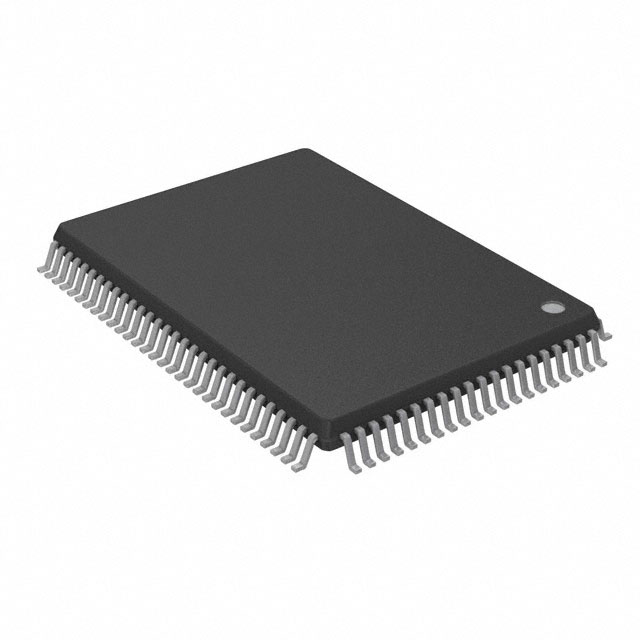MB90F349CESPF-GE1
Product Overview
Category: Microcontroller
Use: Embedded systems, automotive applications
Characteristics: High-performance, low-power consumption
Package: 100-pin LQFP (Low-profile Quad Flat Package)
Essence: Advanced microcontroller for automotive electronics
Packaging/Quantity: Tray packaging, quantity per tray: 250 units
Specifications
- Operating Voltage: 2.7V to 5.5V
- CPU Core: 16-bit CISC
- Clock Frequency: Up to 40 MHz
- Flash Memory: 256 KB
- RAM: 12 KB
- EEPROM: 4 KB
- I/O Ports: 80
- Timers/Counters: 8
- Analog-to-Digital Converter (ADC): 10-bit, 8 channels
- Serial Communication Interfaces: UART, I2C, SPI, LIN
- Operating Temperature Range: -40°C to +105°C
Detailed Pin Configuration
The MB90F349CESPF-GE1 microcontroller has a total of 100 pins. The pin configuration is as follows:
- Pins 1-20: General-purpose I/O (GPIO) pins
- Pins 21-28: Analog input pins
- Pins 29-36: Serial communication interface pins (UART)
- Pins 37-44: Serial communication interface pins (I2C)
- Pins 45-52: Serial communication interface pins (SPI)
- Pins 53-60: Timer/counter pins
- Pins 61-68: Power supply and ground pins
- Pins 69-76: External interrupt pins
- Pins 77-84: Reset and clock pins
- Pins 85-92: Flash memory pins
- Pins 93-100: Other control and I/O pins
Functional Features
- High Performance: The MB90F349CESPF-GE1 microcontroller offers a high clock frequency of up to 40 MHz, enabling fast and efficient processing of instructions.
- Low Power Consumption: With an operating voltage range of 2.7V to 5.5V, this microcontroller ensures low power consumption, making it suitable for battery-powered applications.
- Versatile Serial Communication Interfaces: The UART, I2C, SPI, and LIN interfaces provide flexible options for communication with external devices, allowing seamless integration into various systems.
- Rich I/O Capability: With 80 I/O ports, the MB90F349CESPF-GE1 offers extensive connectivity options for interfacing with sensors, actuators, and other peripheral devices.
- Robust Analog-to-Digital Conversion: The built-in 10-bit ADC with 8 channels enables accurate and reliable analog signal acquisition, essential for automotive applications.
Advantages and Disadvantages
Advantages: - High-performance processing capabilities - Low power consumption for energy-efficient operation - Versatile serial communication interfaces for easy integration - Ample I/O ports for enhanced connectivity - Reliable analog-to-digital conversion for precise measurements
Disadvantages: - Limited on-chip memory compared to some other microcontrollers in the same category - Higher cost compared to entry-level microcontrollers
Working Principles
The MB90F349CESPF-GE1 microcontroller operates based on a 16-bit CISC CPU core. It executes instructions stored in its flash memory, which can be programmed by the user. The microcontroller communicates with external devices through its various serial communication interfaces, such as UART, I2C, SPI, and LIN. It interacts with the surrounding environment through its I/O ports, enabling data exchange with sensors, actuators, and other peripheral devices. The microcontroller's analog-to-digital converter allows it to acquire analog signals accurately for processing and control purposes.
Detailed Application Field Plans
The MB90F349CESPF-GE1 microcontroller finds extensive application in the automotive industry. Some specific application areas include:
- Engine Control Units (ECUs): The microcontroller can be used in ECUs to monitor and control engine parameters, such as fuel injection, ignition timing, and exhaust emissions.
- Body Control Modules (BCMs): It can be employed in BCMs to manage various functions related to vehicle body systems, including lighting, door locks, and climate control.
- Safety Systems: The microcontroller can be utilized in safety systems like airbag control units and anti-lock braking systems (ABS) to ensure timely and accurate responses in critical situations.
- Infotainment Systems: It can be integrated into infotainment systems to provide advanced features like audio/video playback, navigation, and connectivity options.
Detailed and Complete Alternative Models
- **MB
قم بإدراج 10 أسئلة وإجابات شائعة تتعلق بتطبيق MB90F349CESPF-GE1 في الحلول التقنية
Sure! Here are 10 common questions and answers related to the application of MB90F349CESPF-GE1 in technical solutions:
Q1: What is the MB90F349CESPF-GE1 microcontroller used for? A1: The MB90F349CESPF-GE1 microcontroller is commonly used in various technical solutions, including industrial automation, motor control, and automotive applications.
Q2: What is the operating voltage range of the MB90F349CESPF-GE1? A2: The MB90F349CESPF-GE1 operates within a voltage range of 2.7V to 5.5V.
Q3: How much flash memory does the MB90F349CESPF-GE1 have? A3: The MB90F349CESPF-GE1 microcontroller has 128KB of flash memory.
Q4: Can the MB90F349CESPF-GE1 support real-time communication protocols? A4: Yes, the MB90F349CESPF-GE1 supports various real-time communication protocols such as CAN (Controller Area Network) and LIN (Local Interconnect Network).
Q5: Does the MB90F349CESPF-GE1 have built-in analog-to-digital converters (ADCs)? A5: Yes, the MB90F349CESPF-GE1 has two 10-bit ADCs with multiple channels for analog signal conversion.
Q6: What is the maximum clock frequency of the MB90F349CESPF-GE1? A6: The MB90F349CESPF-GE1 can operate at a maximum clock frequency of 20 MHz.
Q7: Can the MB90F349CESPF-GE1 be programmed using C language? A7: Yes, the MB90F349CESPF-GE1 can be programmed using C language, making it easier for developers to write code for their applications.
Q8: Does the MB90F349CESPF-GE1 have any built-in security features? A8: Yes, the MB90F349CESPF-GE1 offers various security features such as a memory protection unit (MPU) and a watchdog timer to enhance system security.
Q9: Can the MB90F349CESPF-GE1 interface with external memory devices? A9: Yes, the MB90F349CESPF-GE1 supports external memory interfaces like SPI (Serial Peripheral Interface) and I2C (Inter-Integrated Circuit) for connecting to external memory devices.
Q10: Is the MB90F349CESPF-GE1 suitable for low-power applications? A10: Yes, the MB90F349CESPF-GE1 is designed to be power-efficient and includes various power-saving modes, making it suitable for low-power applications.
Please note that these answers are general and may vary depending on the specific implementation and requirements of your technical solution.


